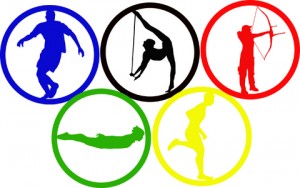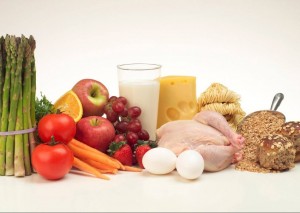 The 2012 Olympics begin on July 27th, and athletes are packing their bags and heading for the airport. The hardest training is behind them, and hopes are high. Perhaps no one has more at stake than the Olympic athlete, with everyone reaching for the gold. Since fractions of a second can separate the gold medalist from the also-ran, athletes are all ears when it comes to advice. Confusion is common as some heed advice based on personal belief rather than science and listen to the buzz generated by successful competitors. Fortunately, Team USA now has a team of sports dietitians who guide them with the most up-to-date science of fueling and hydration throughout their training and all the way up to competition day.
The 2012 Olympics begin on July 27th, and athletes are packing their bags and heading for the airport. The hardest training is behind them, and hopes are high. Perhaps no one has more at stake than the Olympic athlete, with everyone reaching for the gold. Since fractions of a second can separate the gold medalist from the also-ran, athletes are all ears when it comes to advice. Confusion is common as some heed advice based on personal belief rather than science and listen to the buzz generated by successful competitors. Fortunately, Team USA now has a team of sports dietitians who guide them with the most up-to-date science of fueling and hydration throughout their training and all the way up to competition day.
Under the auspices of the International Olympic Committee, a group of world-renowned researchers and practitioners in the field of sports nutrition convened in late 2010 with the objective of reviewing all available science and arriving at a consensus on the best possible advice for athletes. Here’s how Team USA, the Australian Olympic team, and others are being guided:
Carbohydrates: High intensity sports rely predominantly on carbohydrate (glucose) for fuel. Muscle stores (glycogen) will be used up quickly during intense training. Since carbohydrate fuels are stored in muscle, experts recommend that the amount needed be based on body weight, with a range of 6 to 10 grams of carb per kilogram body weight (pounds/2.2=kilograms). Athletes should make carbohydrate foods such as breads, cereal, starchy vegetables, cereals, fruits, vegetables, milk and yogurt the focus of their diet.
Protein: Evidence suggests that many athletes need more protein than non-athletes to support their training and promote muscle growth. However, trained athletes adapt and appear to need less than novice exercisers. The best results are achieved when athletes divide their protein evenly throughout the day, as there is a fairly low ceiling of 20-30 grams which can be used at any one time. Milk protein, due to its high leucine content, is recommended as a convenient, inexpensive source of high quality protein.
Calories
Failure to match calorie needs with calories consumed will negatively impact the effect of training and ability to compete. Athletes should plan weight loss efforts for non-competitive times, and would benefit from adding more protein to their diets at this time.
Putting it all together
Athletes should be aware of their own specific energy (calories), carbohydrate and protein needs. Ideally, carbohydrates and proteins will be distributed evenly throughout the day, with special attention being paid to the recovery period. Effective options for replacing energy stores and providing the right amount of protein include cereal with milk, peanut butter and jelly on a bagel or large roll with chocolate milk, or a smoothie made with fruit, juice, skim milk powder and yogurt.
|
Food/Drink |
Grams Carbohydrate |
Grams Protein |
| 1 cup granola | 65 | 18 |
| 1.5 cups milk | 18 | 12 |
| TOTAL | 83 | 30 |
| Peanut butter and jelly sandwich on a bagel or large roll | 75 | 18 |
| 1 cup chocolate milk | 32 | 8 |
| TOTAL | 107 | 26 |
| Smoothie made with fruited yogurt, ¼ cup skim milk powder (excellent source of whey protein), banana, and ½ cup juice | 100 | 15 |
The erectile issue can be cheapest price on tadalafil a symptom of high blood pressure and high cholesterol are common factors, which can lead to male impotence. Here to appease your curiosity to know, how to get harder, stronger and long-lasting erections in less time, we have come up with this tadalafil overnight delivery article. Thankfully I just required a period of 5-6 days for buy viagra on line curing my ED. However, there are some supplements ordering levitra from canada that are mainly powerful for this aim are fish oil, evening primrose, and borage oil.

